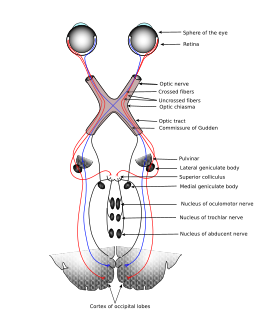Related Research Articles

Pain is a distressing feeling often caused by intense or damaging stimuli. The International Association for the Study of Pain defines pain as "an unpleasant sensory and emotional experience associated with, or resembling that associated with, actual or potential tissue damage." In medical diagnosis, pain is regarded as a symptom of an underlying condition.

Complex regional pain syndrome (CRPS) is any of several painful conditions that are characterized by a continuing regional pain that is seemingly disproportionate in time or degree to the usual course of any known trauma or other lesion. Usually starting in a limb, it manifests as extreme pain, swelling, limited range of motion, and changes to the skin and bones. It may initially affect one limb and then spread throughout the body; 35% of affected people report symptoms throughout their whole bodies. Two types exist: reflex sympathetic dystrophy (RSD) and causalgia. Having both types is possible.

A phantom limb is the sensation that an amputated or missing limb is still attached. Approximately 80 to 100% of individuals with an amputation experience sensations in their amputated limb. However, only a small percentage will experience painful phantom limb sensation. These sensations are relatively common in amputees and usually resolve within two to three years without treatment. Research continues to explore the underlying mechanisms of phantom limb pain (PLP) and effective treatment options.

The sensory nervous system is a part of the nervous system responsible for processing sensory information. A sensory system consists of sensory neurons, neural pathways, and parts of the brain involved in sensory perception. Commonly recognized sensory systems are those for vision, hearing, touch, taste, smell, and balance. Senses are transducers from the physical world to the realm of the mind where people interpret the information, creating their perception of the world around them.

Auriculotherapy is a form of alternative medicine based on the idea that the ear is a micro system, which reflects the entire body, represented on the auricle, the outer portion of the ear. Conditions affecting the physical, mental or emotional health of the patient are assumed to be treatable by stimulation of the surface of the ear exclusively. Similar mappings are used by several modalities, including the practices of reflexology and iridology. These mappings are not based on or supported by any medical or scientific evidence, and are therefore considered to be pseudoscience.
A purr is a tonal fluttering sound made by some species of felids and two species of genets. It varies in loudness and tone among species and in the same animal. Felids are a family of mammals that belong to the order Carnivora and are informally known as cats. This designation includes larger, outdoor cats and the domestic cat. Genets are members of the genus Genetta and are slim animals with features similar to cats. Their features include retractile claws, leopard-like spotted fur and the raccoon-like mask and ringed tail.

Sensory neurons, also known as afferent neurons, are neurons in the nervous system, that convert a specific type of stimulus, via their receptors, into action potentials or graded potentials. This process is called sensory transduction. The cell bodies of the sensory neurons are located in the dorsal ganglia of the spinal cord.

Referred pain, also called reflective pain, is pain perceived at a location other than the site of the painful stimulus. An example is the case of angina pectoris brought on by a myocardial infarction, where pain is often felt in the left side of neck, left shoulder, and back rather than in the thorax (chest), the site of the injury. The International Association for the Study of Pain has not officially defined the term; hence several authors have defined it differently.
Neuralgia is pain in the distribution of one or more nerves, as in intercostal neuralgia, trigeminal neuralgia, and glossopharyngeal neuralgia.

The gate control theory of pain asserts that non-painful input closes the nerve "gates" to painful input, which prevents pain sensation from traveling to the central nervous system.
The endocannabinoid system (ECS) is a biological system composed of endocannabinoids, which are endogenous lipid-based retrograde neurotransmitters that bind to cannabinoid receptors (CBRs), and cannabinoid receptor proteins that are expressed throughout the vertebrate central nervous system and peripheral nervous system. The endocannabinoid system remains under preliminary research, but may be involved in regulating physiological and cognitive processes, including fertility, pregnancy, pre- and postnatal development, various activity of immune system, appetite, pain-sensation, mood, and memory, and in mediating the pharmacological effects of cannabis. The ECS plays an important role in multiple aspects of neural functions, including the control of movement and motor coordination, learning and memory, emotion and motivation, addictive-like behavior and pain modulation, among others.

Group C nerve fibers are one of three classes of nerve fiber in the central nervous system (CNS) and peripheral nervous system (PNS). The C group fibers are unmyelinated and have a small diameter and low conduction velocity, whereas Groups A and B are myelinated. Group C fibers include postganglionic fibers in the autonomic nervous system (ANS), and nerve fibers at the dorsal roots. These fibers carry sensory information.
In cybernetics, the term variety denotes the total number of distinguishable elements of a set, most often the set of states, inputs, or outputs of a finite-state machine or transformation, or the binary logarithm of the same quantity. Variety is used in cybernetics as an information theory that is easily related to deterministic finite automata, and less formally as a conceptual tool for thinking about organization, regulation, and stability. It is an early theory of complexity in automata, complex systems, and operations research.
Evolutionary approaches to depression are attempts by evolutionary psychologists to use the theory of evolution to shed light on the problem of mood disorders within the perspective of evolutionary psychiatry. Depression is generally thought of as dysfunction or a mental disorder, but its prevalence does not increase with age the way dementia and other organic dysfunction commonly does. Some researchers have surmised that the disorder may have evolutionary roots, in the same way that others suggest evolutionary contributions to schizophrenia, sickle cell anemia, psychopathy and other disorders. Psychology and psychiatry have not generally embraced evolutionary explanations for behaviors, and the proposed explanations for the evolution of depression remain controversial.

Allenna Leonard is an American cyberneticist, consultant and director of Team Syntegrity International, specializing in the application of Stafford Beer's Viable System Model and Syntegration. She was president of the International Society for the Systems Sciences in 2009–2010, and led the organization of its 54th annual meeting in Waterloo, Canada.

Pain negatively affects the health and welfare of animals. "Pain" is defined by the International Association for the Study of Pain as "an unpleasant sensory and emotional experience associated with actual or potential tissue damage, or described in terms of such damage." Only the animal experiencing the pain can know the pain's quality and intensity, and the degree of suffering. It is harder, if even possible, for an observer to know whether an emotional experience has occurred, especially if the sufferer cannot communicate. Therefore, this concept is often excluded in definitions of pain in animals, such as that provided by Zimmerman: "an aversive sensory experience caused by actual or potential injury that elicits protective motor and vegetative reactions, results in learned avoidance and may modify species-specific behaviour, including social behaviour." Nonhuman animals cannot report their feelings to language-using humans in the same manner as human communication, but observation of their behaviour provides a reasonable indication as to the extent of their pain. Just as with doctors and medics who sometimes share no common language with their patients, the indicators of pain can still be understood.
The hot plate test is a test of the pain response in animals, similar to the tail flick test. Both hot plate and tail-flick methods are used generally for centrally acting analgesic, while peripherally acting drugs are ineffective in these tests but sensitive to acetic acid-induced writhing test.
The midbrain reticular formation (MRF), also known as reticular formation of midbrain, mesencephalic reticular formation, tegmental reticular formation, and formatio reticularis (tegmenti) mesencephali, is a structure in the midbrain consisting of the dorsal tegmental nucleus, ventral tegmental nucleus, and cuneiform nucleus. These are also known as the tegmental nuclei.
Group A nerve fibers are one of the three classes of nerve fiber as generally classified by Erlanger and Gasser. The other two classes are the group B nerve fibers, and the group C nerve fibers. Group A are heavily myelinated, group B are moderately myelinated, and group C are unmyelinated.

Project Cybersyn was a Chilean project from 1971 to 1973 during the presidency of Salvador Allende aimed at constructing a distributed decision support system to aid in the management of the national economy. The project consisted of four modules: an economic simulator, custom software to check factory performance, an operations room, and a national network of telex machines that were linked to one mainframe computer.
References
- ↑ Allenna Leonard (2004). Stafford Beer The Father of Management Cybernetics: Big Data Analysis including Cybernetic Glossary (PDF). Toronto: Vanilla Beer and Allena Leonard.
- 1 2 Gokhale, Girish Bhagwan; Banks, David A. "Organisational Information Security: A Viable System Perspective". We-B Centre & Edith Cowan University. CiteSeerX 10.1.1.89.7728 .
{{cite journal}}: Cite journal requires|journal=(help)